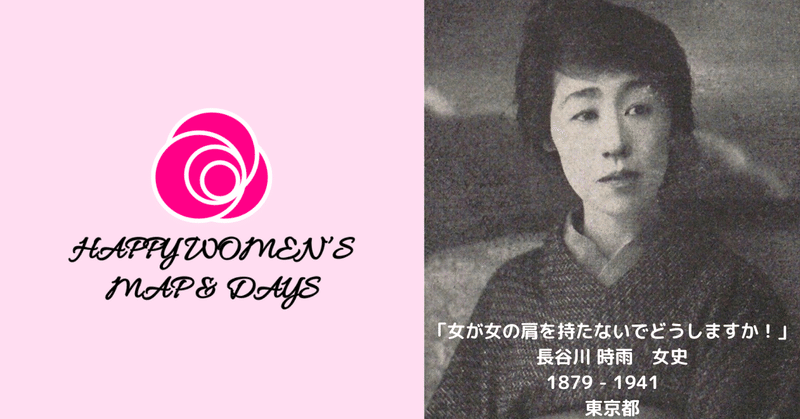
Happy Women's Map 東京都 日本初の女性歌舞伎脚本家・『女人藝術』また日本女流文学者会の立役者 長谷川 時雨 女史

「女が女の肩を持たないでどうしますか!」
"Become a good ally for women. What if we don't ?"
長谷川 時雨 女史
Ms. Shigure Hasegawa
1879 - 1941
東京都中央区小伝馬町 生誕
Born in Kodenma-tyo, Chuo-ku, Tokyo-to
長谷川時雨は日本初の女性歌舞伎脚本家であり、さらに、女性のための思想・文学・芸術に関する雑誌『女人藝術』を発刊しながら、日本の女性の文化芸術活動を支えました。
Hasegawa Shiguru is the Japan's first female Kabuki playwrighter, and principal moving force for Japanese women's art by founding a female literary journal "Nyonin Geijyutsu".
*******
病弱ではみかみ屋の「あんぽんたん」
時雨こと康子は1879年東京府日本橋区に、御用呉服屋の息子で免許代言人(弁護士)の父と、没落士族の娘で苦労人の母親のもと6人兄弟の長女として生まれます。病弱ではにかみ屋の「アンポンタン」として、もと御殿女中で呉服商家を盛り立てた祖母に溺愛されて育てられます。祖母や母の教育方針で学校へは上がらず、寺子屋での読み書きそろばんに裁縫・長唄・日本舞踊・二絃琴・生け花・茶の湯を身に着けます。母・多喜は、康子が読書をすると目の前で本をビリビリに破って燃やし、康子を激しく殴打して蔵に閉じ込めます。祖母・小りんは、康子が下田歌子の私塾に通うのを阻止、かわりに康子を連れて芝居小屋へ通います。14歳になると行儀見習いに池田詮政侯爵家に奉公に出されます。康子は給料を書籍につぎ込んで夜分に読書に耽ります。3年目で肋膜炎を病んで家に戻されると、父の伝手で著名な歌人で国文学者の佐佐木信綱が主宰する「竹柏園」に通うことを許されます。康子は仕事を済ませるとご飯もろくに食べずに通りを急いで、嬉々として源氏物語や万葉集の古典を学びます。
「いやだいやだいだ」
康子は18歳のときに、両親の命で成金で評判の悪い鉄問屋・水橋家の次男・信蔵と結婚。嫁ぎ先では上品ぶってると悪口を言われ、書きものをするとはばかりに捨てらます。康子は家族の外出時には留守番をして読書に浸ります。しばらくして、父・深造が水橋家絡みの東京市議会を巻き込んだ贈収賄事件により公職を辞します。康子は離婚を申し出るも叶わず、実家から勘当された夫・信蔵とともに、岩手・釜石の鉱山町に移り住みます。夫・信蔵は東京へ行って放蕩三昧で帰ってこず、康子は釜石で独り小説を書いて明け暮らします。22歳の時に雑誌『女学世界』に投稿した短編『うづみ火』が特賞に選ばれ、投稿を繰り返す中で注目を集めるようになります。25歳で離婚を決意して帰京、隠居中の父・深造と佃島の屋敷に住みながら、築地の女子語学校(今の雙葉学園)の初等科に通って英語を学びます。26歳のときに読売新聞に応募した戯曲「海潮音」が演劇界の大御所・坪内逍遙に絶賛されて入選、新派の喜多村緑郎、伊井蓉峰らによって上演されます。初めての女性脚本による歌舞伎として舞台挨拶に立ったり、ブロマイド写真を売り出して注目を集めます。
「あたしはまっしぐらに、所信のあるところへ、火のような熱情をもって突きすすんでいった。」
康子は逍遙に師事しながら新舞踊劇を創作、日本海事協会に当選した「覇王丸」を「花王丸」と改題して市村羽左衛門と歌舞伎座で上演。この頃、釜石時代から文通していた中谷徳太郎と交際をはじめ、共同で『シバヰ』を発行。六代目尾上菊五郎らと結成した『舞踊協会』『狂言座』でも彼の作品を公演します。30歳から古今の女性を題材にした美人伝・名婦伝を『読売新聞』『東京朝日新聞』『婦人画報』『婦人公論』などに発表、話題を集めます。その頃、ひとまわり年下の作家・三上於菟吉から熱烈な求愛を受けて結婚、献身的に支えます。同時に甥っ子を引き取り、母と旅館の経営を始め、家庭の仕事に追われるようになります。やがて売れ出した夫・於菟吉が妾を囲い芸者を侍らせ放蕩三昧となる中、康子は44歳で岡田八千代との同人雑誌『女人芸術』を創刊。女性作家たちに自由な活動の場を与えるも、関東大震災により2号で廃刊します。49歳のとき夫・於菟吉の資金援助のもと、仲間割れで廃刊していた『青鞜』メンバーを迎え入れて『女人芸術』を再興。自伝的作品『旧聞日本橋』の連載を始めて人気を集めます。康子は思想弾圧を受けて困窮する左翼の女性作家も受け入れ、たびたび発禁処分を受け資金に行き詰まります。53歳のとき『輝ク会』を結成して機関紙『輝ク』を創刊。日中戦争開始とともに『皇軍慰問号』を発行、銃後慰問団体『輝ク部隊』を結成、陸海軍資金援助・監修により3冊の文集『輝ク部隊』『海の銃後』『海の勇士慰問文集』を制作。同時に康子は脳血栓で倒れた夫・於菟吉を看病しながら彼の新聞連載を代筆、さらに『輝ク部隊』を引き連れて中国厦門から広東へ、南シナ海を渡って海南島へ、さらに仏印まで足をのばそうというところで戦況が激化して引き返します。疲れ果てて帰国すると、体に鞭打って日本女流文学者会を発足する中で発病、61歳で没します。
岡田八千代、野上弥生子、神近市子、山川菊栄、三宅やす子、島本久恵、富本一枝、高群逸枝、長谷川春子、湯浅芳子、尾崎翠、野溝七生子、宮本百合子、望月百合子、真杉静枝、大谷藤子、戸田豊子、平林英子、林芙美子、中本たか子、村山籌子、佐多稲子、竹内てるよ、平林たい子、円地文子、松田解子、矢田津世子、大田洋子、若林つや、田村俊子、柳原白蓮、平塚らいてう、長谷川かな女、深尾須磨子、岡本かの子、鷹野つぎ、高群逸枝、八木あき、坂西志保、板垣直子、中村汀女、大谷藤子、森茉莉、林芙美子、窪川稲子、平林たい子、円地文子、田中千代、大石千代子、吉屋信子らとともに女性の自由な活躍の場を広げました。
Bushful of "Anpontan"
Shigure, also known as Yasuko, was born in 1879 in the Nihonbashi district of Tokyo, Japan. She was the eldest of six siblings, born to a father who was a licensed representative (lawyer) and the son of a high-class kimono shop, and a mother from a fallen samurai family with a history of hardship. Being of fragile health, she was affectionately called the "Anpontan" of Bushful. She was raised with great love by her grandmother, who had previously been a lady-in-waiting and had played a significant role in the kimono business. She was instrumental in bringing the family back to prosperity. Guided by the educational principles of her grandmother and mother, Yasuko did not attend regular school. Instead, she received education at a temple school where she learned reading, writing, abacus, sewing, Noh theater, Japanese dance, the shamisen, ikebana (flower arranging), and the tea ceremony. Ysuko's mother, Taki, had a habit of tearing apart and burning books in front of her daughter whenever she found her reading. She would also physically abuse Yasuko and lock her in the storehouse. On the other hand, her grandmother, Korin, prevented Yasuko from attending Shirauta's private school and instead took her to the theater. At the age of 14, Yasuko was sent to serve as a maid in the house of Marquis Ikeda Shigenobu to learn manners and etiquette. Despite her official duties, Koyuko devoted her salary to buying books, which she would read late into the night. After falling ill with pleurisy during her third year of service, she was sent back home. With the help of her father, she was then allowed to attend "Chikubaien," a literary circle led by the renowned poet and scholar, Sasaki Nobutsuna. Yasuko, was eager to learn classical literature and ancient texts, such as The Tale of Genji and the Manyoshu (Collection of Ten Thousand Leaves). After finishing her chores, she would hurriedly walk to the gatherings to study these classics with enthusiasm, often neglecting her meals.
"NO, NO, NO!"
Yasuko married Shozo, the second son of the wealthy and notorious iron merchant, the Mizuhashi family when she was 18 years old. At her new home, she was treated poorly and badmouthed for acting pretentious. Whenever her family was out, Yasuko immersed herself in reading. After a while, her father Shigezo resigned from his public office due to a bribery scandal involving the Mizuhashi family's connections with the Tokyo City Council. Yasuko proposed divorce but it was not granted, so she, along with her husband, Shozo, who had been disowned by her family, moved to a mining town in Kamaishi, Iwate. Shozo frequently traveled to Tokyo for a life of debauchery, leaving Yasuko alone in Kamaishi, where she devoted her time to writing novels. At the age of 22, her short story "Uzumibi" won a special prize when submitted to the magazine "Jogaku Sekai," garnering attention. She decided to divorce at the age of 25 and returned to Tokyo, where she lived in the residence of her retired father, Shigezo, on Tsukishima. While there, she attended the primary school of the Tsukishima Women's Language School (now known as Futaba Gakuen) to study English. When she was 26, her submitted play, "Kaishion," was highly praised by the leading figure of the theater world, Shoyo Tsubouchi, and it was selected for production by the Shinpa theater group, starring Rokuro Kitamura and Yutaka Ii. As the first female playwright of a kabuki play, Yasuko made appearances during curtain calls and promoted herself through bromide photographs, drawing significant attention.
"I rushed forward with unwavering conviction, burning with fiery passion."
While studying under Shoyo Tsubouchi, Yasuko created a new dance drama. She renamed "Haomaru," originally selected for the Japan Maritime Association, to "Kaomaru" and staged it at the Kabuki-za Theater with actor Ichimura Uzaemon. During this time, she began a relationship with Tokutaro Nakatani, whom she had been corresponding with since her time in Kamaishi, and they jointly published "Shibai." Yasuko's works were also performed in "Dance Association" and "Kyogen-za," which she established with the sixth-generation Onoe Kikugoro. Starting at the age of 30, she published stories of beautiful women and remarkable women from ancient to modern times in newspapers and magazines such as "Yomiuri Shimbun," "Tokyo Asahi Shimbun," "Fujin Gahō," and "Fujin Kōron," attracting attention. During this time, she received passionate proposals of marriage from writer Utakichi Mikami, a year younger than her, and they got married. She dedicatedly supported him. At the same time, she took in her nephew, started running a ryokan with her mother, and became busy with household chores. While her husband, Utakichi, enjoyed a life of debauchery, having mistresses and geishas, Yasuko, at the age of 44, founded the literary magazine "Josei Geijutsu" with members of the "Seitō" group, but it was discontinued after the second issue due to the Great Kanto Earthquake. When she was 49, with financial support from her husband, Utakichi, she welcomed members of the disbanded "Seito" group to revive "Josei Geijutsu." Her autobiographical work "Kyūmon Nihonbashi" started serialization and became popular. Yasuko accepted left-wing female writers who were suffering due to ideological suppression, frequently faced bans on their works, and struggled financially. At the age of 53, she formed the "Kagayaku-kai" and launched the magazine "Kagayaku." With the start of the Second Sino-Japanese War, she issued the "Imperial Army Comfort" magazine, formed the "Kagayaku Unit" for rear-area comfort activities, and produced three volumes of collected essays: "Kagayaku Unit," "Women Behind the Army," and "Sea Heroes Comfort Essay Collection," with financial support and supervision from the Imperial Japanese Army and Navy. At the same time, Yasuko cared for her husband, Utakichi, who had collapsed due to cerebral thrombosis, wrote his newspaper serials, and, along with the "Kagayaku Unit," set out from China's Xiamen to Guangdong, crossed the South China Sea to Hainan Island, and was planning to continue to French Indochina when the war escalated, forcing her to return. Exhausted and returning home, she founded the Japan Women Writers Association and fell ill while whipping her body to work. She passed away at the age of 61.
Together with women like Okada Yachiyo, Nogami Yaeko, Kinkichi Ichiko, Yamakawa Kikue, Miyake Yasuko, Shimamoto Hisae, Tomimoto Kazue, Takagune Itsue, Hasegawa Haruko, Yuasa Yoshiko, Ozaki Midori, Nogō Nanako, Miyamoto Yuriko, Mochizuki Yuriko, Masugi Shizue, Ōta Fujiko, Toda Toyoko, Hirabayashi Hanako, Hayashi Fumiko, Nakamoto Takako, Murayama Chōko, Sata Inako, Takeuchi Teruyo, Hirabayashi Taiko, Endo Fumiko, Matsuda Tokiko, Yatatsu Yoko, Ota Yoko, Wakabayashi Tsuya, Tamura Toshiko, Yanagihara Hakuren, Hiratsuka Raichō, Hasegawa Kanajo, Fukao Sumako, Okamoto Kanoko, Takano Tsugi, Takagune Itsue, Yagi Aki, Sakai Shiho, Itagaki Naoko, Nakamura Teijo, Ota Yoko, Mori Mari, Hayashi Fumiko, Kubogawa Inako, Hirabayashi Taiko, Endo Fumiko, Tanaka Chiyo, Ōishi Chiyoko, and Yoshiya Nobuko, Yasuko expanded the space for women to pursue their creative freedom.
-東京都中央区立郷土資料館 Tokyo Chuo City Museum

Share Your Love and Happy Women's Story!
あなたを元気にする女性の逸話をお寄せください!
Share your story of a woman that inspires you!
この記事が気に入ったらサポートをしてみませんか?
